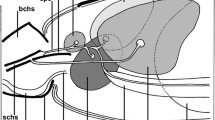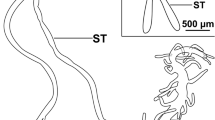Abstract
The gross morphological changes in the salivary glands ofIxodes ricinus (L.) were investigated at the light microscopic level in various phases off the host with emphasis on the engorged nymph, in order to relate the capability of active vapour uptake in the course of postembryonal development to degeneration and regeneration of salivary-gland alveoli.
Agranular alveoli in engorged immatures ofI. ricinus, from detachment to the following early pharate phase, do not appear different from those of the unfed instars. This is also true for the female up to approximately the end of oviposition. During moulting, the agranular alveoli of the immatures degenerate and new ones are formed which are apparently already functional in teneral nymphs and adults. In contrast, granular alveoli, much enlarged in freshly detached immatureI. ricinus, shrivel in the early post-repletion period and soon reach a highly reduced state which is maintained until apolysis. Subsequently, they disintegrate completely.
The finding that engorged and detached immatures ofI. ricinus with markedly atrophied granular alveoli are capable of active vapour uptake until some days after initiation of apolysis suggests that only agranular alveoli are responsible for producing the primary secretion involved in vapour uptake.
Similar content being viewed by others
References
Balashov, Y.S., 1965. Mechanism of salivation and morphologic-histochemical peculiarities of the salivary glands in ixodid ticks (Acarina, Ixodoidea). Entomol. Rev., 44: 462–472.
Ballashov, Y.S., 1968. Bloodsucking ticks (Ixodoidea)-vectors of diseases of man and animals. Misc. Publ. Entomol. Soc. Am., 8: 161–376 (1972, English translation).
Barker, D.M., Ownby, C.L., Krolak, J.M., Claypool, P.L. and Sauer, J.R., 1984. The effect of attachment, feeding, and mating on the morphology of the type I alveolus of salivary glands of the lone star tick,Amblyomma americanum (L.). J. Parasitol., 70: 99–113.
Chinery, W.A., 1965. Studies on the various glands of the tickHaemaphysalis spinigera Neumann 1897. Part III. The salivary glands. Acta Trop., 22: 321–349.
Diehl, P.A., Connat, J.-L. and Dotson, E., 1986. Chemistry, function and metabolism of tick ecdysteroids. In: J.R. Sauer and J.A. Hair (Editors), Morphology, Physiology, and Behavioral Biology and Ticks, Ellis Horwood, Chichester, pp. 165–193.
Dzhafarov, T.E., 1965. An electron microscopy investigation of pyramidal alveoli of salivary glands of certain ticks. In: An Electron and Fluorescent Microscope Study of the Cell. Izd. Akad. Nauk SSSR; Leningrad, pp. 31–37 (English transl. NAMRU 3-T 1233).
Harris, R.A. and Kaufman, W.R., 1981. Hormonal control of salivary gland degeneration in the ixodid tickAmblyomma hebraeum. J. Insect. Physiol., 27: 241–248.
Harris, R.A. and Kaufman, W.R., 1985. Ecdysteroids: possible candidates for the hormone which triggers salivary gland degeneration in the ixodid tickAmblyomma hebraeum. Experientia, 41: 740–742.
Kahl, O., 1989. Untersuchungen zum Wasserhaushalt von Zecken (Acari: Ixodoidea) im Laufe ihrer postembryonalen Entwicklung unter besonderer Berücksichtigung der aktiven Wasserdampfsorption bei gesogenen Stadien. Ph.D. Thesis, Free University of Berlin, 356 pp.
Kahl, O. and Knülle, W., 1986. Water vapour uptake by engorged immature ixodid ticks. In: H. Velthuis (Editor), Proc. 3rd European Congress of Entomology, Amsterdam, 24–29 August 1986, Part 2. Amsterdam Univ. Press, Utrecht, pp. 275–278.
Kahl, O. and Knülle, W., 1988. Water vapour uptake from subsaturated atmospheres by engorged immature ixodid ticks. Exp. Appl. Acarol., 4: 73–83.
Kaufman, W.R., 1983. The function of tick salivary glands. In: K.F. Harris (Editor), Current Topics in Vector Host Research, Vol. 1. Praeger Scientific, New York, pp. 215–247.
Kaufman, W.R., 1986. Salivary gland degeneration in the female tick,Amblyomma hebraeum Koch (Acari: Ixodidae). In: J.R. Sauer and J.A. Hair (Editors), Morphology, Physiology, and Behavioral Biology of Ticks, Ellis Horwood, Chichester, pp. 46–54.
Kaufman, W.R. and Sauer, J.R., 1982. Ion and water balance in feeding ticks: mechanisms of tick excretion. In: F.D. Obenchain and R.L. Galun (Editors), Physiology of Ticks. Pergamon Press, Oxford, pp. 213–244.
Krolak, J.M., Ownby, C.L. and Sauer, J.R., 1982. Alveolar structure of salivary glands of the lone star tick,Amblyomma americanum (L.): unfed females. J. Parasitol., 68: 61–82.
Lees, A.D., 1946. The water balance inIxodes ricinus L. and certain other species of ticks. Parasitology, 37: 1–20.
Lindsay, P.J. and Kaufman, W.R., 1988. Action of some steroids on salivary gland degeneration in the ixodid tick,A. americanum L. J. Insect Physiol., 34: 351–359.
McMullen, H.L., Sauer, J.R. and Burton, R.L., 1976. Possible role in uptake of water vapour by ixodid tick salivary glands. J. Insect Physiol., 22: 1281–1285.
Megaw, M.W.J. and Beadle, D.J., 1979. Structure and function of the salivary glands of the tick,Boophilus microplus, Canestrini (Acarina: Ixodidae). Int. J. Insect Morphol. Embryol., 8: 67–83.
Needham, G.R. and Coons, L.B., 1984. Ultrastructural changes in type I alveoli of the salivary glands from hydrating and desiccating lone star ticks. In: D.A. Griffiths and C.E. Bowman (Editors), Acarology VI. Vol. 1. Ellis Horwood, Chichester, pp. 366–373.
Needham, G.R. and Teel, P.D., 1986. Water balance by ticks between bloodmeals. In: J.R. Sauer and J.A. Hair (Editors), Morphology, Physiology, and Behavioral Biology of Ticks. Ellis Horwood, Chichester, pp. 100–151.
Reichenow, E., 1940. Der Entwicklungsgang des Küstenfiebererregers im Rinde und in der übertragenden Zecke. Arch. Protistenkd., 94: 1–56.
Rudolph, D. and Knülle, W., 1974. Site and mechanism of water vapour uptake from the atmosphere in ixodid ticks. Nature, 249: 84–85.
Rudolph, D. and Knülle, W., 1978. Uptake of water vapour from the air: process, site and mechanism in ticks. In: K. Schmidt-Nielsen, L. Bolis and S.H.P. Maddrell (Editors), Comparative Physiology: Water, Ions and Fluid Mechanics. Cambridge Univ. Press, Cambridge, pp. 97–113.
Samson, K., 1909. Zur Anatomie und Biologie vonIxodes ricinus L. Z. Wiss. Zool., 93: 185–236.
Sauer, J.R. and Hair, J.A., 1971. Water balance in the lone star tick (Acarina: Ixodidae): the effects of relative humidity and temperature on weight changes and total water content. J. Med. Entomol., 8: 479–485.
Sweatman, G.K., 1967. Physical and biological factors affecting the longevity and oviposition of engorgedRhipicephalus sanguineus female ticks. J. Parasitol., 53: 432–445.
Till, W.M., 1961. A contribution to the anatomy and histology of the brown ear tick,Rhipicephalus appendiculatus (Neumann). Mem. Entomol. Soc. South. Afr., 6: 1–124.
Walker, A.R. and Fletcher, J.D., 1985. Age grades and infection rates ofRhipicephalus appendiculatus Neumann (Acari: Ixodidae) to assess theileriosis challenge in the field. Bull. Entomol. Res., 75: 653–660.
Walker, A.R., Fletcher, J.D. and Gill, H.S., 1985. Structural and histochemical changes in the salivary glands ofRhipicephalus appendiculatus during feeding. Int. J. Parasitol., 15: 81–100.
Winston, P.W. and Bates, D.H., 1960. Saturated solutions for the control of humidity in biological research. Ecology, 41: 232–237.
Yanagawa, H., Mori, T., Shiraishi, S. and Uchida, T.A., 1987. Ultrastructural changes in the salivary gland of the female cattle tick,Haemaphysalis longicornis, during feeding. J. Zool., 212: 283–301.
Author information
Authors and Affiliations
Rights and permissions
About this article
Cite this article
Kahl, O., Hoff, R. & Knülle, W. Gross morphological changes in the salivary glands ofIxodes ricinus (Acari, Ixodidae) between bloodmeals in relation to active uptake of atmospheric water vapour. Exp Appl Acarol 9, 239–258 (1990). https://doi.org/10.1007/BF01193431
Accepted:
Issue Date:
DOI: https://doi.org/10.1007/BF01193431




